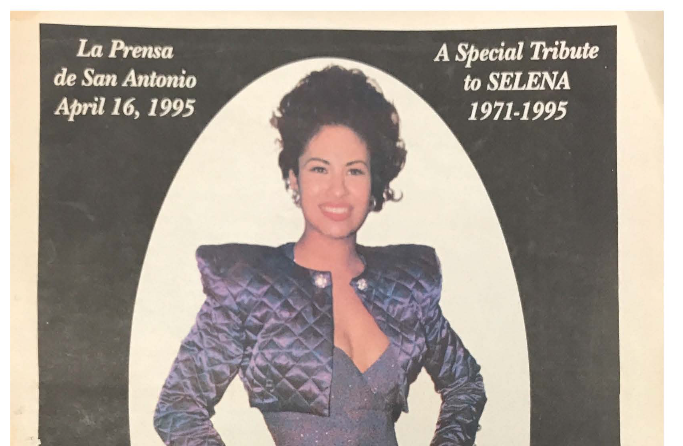Selena was no ordinary queen. She was the queen of Tejano music. Her empire included music fans from the United States and Mexico and beyond. Her songs crossed international borders and were sung in English and Spanish.
To help celebrate the day of her birth, I asked San Antonio photographer Al Rendon, who knew her well, to take us back to the days when Selena ruled the Tejano radio waves and media.
Rendon began following Selena’s career when she earned recognition at the Tejano Music Awards in the late 1980s. Selena, who had started her band, Selena y Los Dinos, when she was eleven years old, was a rising young star by her early teens.
In 1992, the recording company Capitol Records EMI Latin had a problem—no one liked the photos proposed for the new album which was due in the stores that spring. Thus, Rendon got his big break to photograph Selena for the cover of her upcoming album, Entre a Mi Mundo. (Come into my World).
On a cold winter day, Selena’s bus pulled up to the studio that Rendon had rented for this emergency situation. The band was on its way to a venue, and there wasn’t much time. Rendon remembers that Selena came in with only her family. She brought along several outfits that she had designed herself.
Rendon could not have known at the time, but this album would be her breakthrough creation. Her songs recorded in Entre a Mi Mundo were influenced by R&B, pop, and disco, but also by her personal style of Colombian cumbias. Selena believed that this rich blend of music required special clothing design. She loved fashion design almost as much as singing her music.
The photo shoot went extremely well. Selena’s charm and humility were evident from the start. Rendon’s challenges were that Selena and her dad did not agree on what outfits she was to wear. Finally, her dad left the room and Selena posed for what would be an iconic photo– Selena in a mid-drift top, black and white striped sleeves, sparkling pants and her arms lifting her long black hair.
Selena really liked the photo and, as a result, there would be many other photo shoots for Rendon. In addition, he photographed Selena at various performances and at the Tejano Music Awards. In the studio, as on the stage, she was a natural performer and required few directions, according to Rendon.
When Coca Cola selected Selena for their promotional ads, they chose Rendon to handle the photography. In the past, Coca Cola had used photographers from Los Angeles and New York. But with the advice of their ad guru, Lionel Sosa of San Antonio, they agreed to try Rendon. The photo shooting for these ads was intense and complicated. Selena made shooting easier by coming prepared with a dozen colorful outfits, all which she had designed. After the successful photo sessions, she recognized Rendon’s creative ability and made sure he would have future opportunities to photograph her on stage.
The year following her Entre a Mi Mundo album, Selena appeared in several telenovelas, including “Dos Mujeres.” Her popularity was growing as evident by the 70,000 attendees who saw her perform at the Féria Expomex in Nuevo Laredo in September 1993. That same year over 55,000 fans saw her perform at the Houston Astrodome.
Her fan base expanded as more and more Mexican radio stations began playing her recordings. Selena’s music had a special Latino rhythm and appealed to South America audiences as well. By 1994 she had also branched out to create her own line of clothing and make-up. Her popularity extended beyond Tejano fans. To young girls of all races and color, Selena represented an ideal role model. She exhibited an extensive singing range and musical versatility as she belted out love songs, cumbias, and rancherias. In addition, her fans saw her as a beautiful and sexy person with an eye for designing new fashion styles.
Her fans adored her, which was no doubt a reason that Coca Cola singled her out for promotions. She had that wholesome Tejana look. Some might say that she had the All American look while others pointed to her tremendous sex appeal. Selena was indeed the first Latina megastar and her popularity during the early 1990s grew with every record release and every performance.
Her first Tejano album “Ven Conmigo” recorded in 1990 had sold over 500,000 copies by the time she received her Grammy Award in 1993. Despite her growing star status, she changed little and gave her fans abundant time and attention.
Her highly successful musical career and marriage to her band guitarist Chris Perez suggested an idyllic life. It seemed so to her. But her dream would soon turn in a horrendous nightmare.
Rendon recalled that Selena had a good heart and trusted many. Her trust was betrayed in March of 1995 as she opened a second Selena, Etc. store in San Antonio. That spring her family had discovered fraud and theft connected to a trusted business manager.
Her death at the hands of someone she had helped so much, shocked family, friends, and fans. It all seemed like a bad dream. Her friend Rendon remembers an astonishing amount of grieving and mourning that followed her tragic death. Every Latino community created altars to her and candles were lit in churches and homes.
Selena died in her adopted hometown of Corpus Christi, but not even death could silence her. Her music lives on. On April 16 of this year, she would have celebrated her 48th birthday. Her life is one that millions will never forget. Viva Selena.


Recent Comments